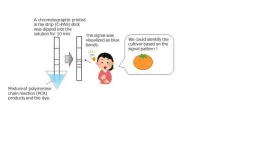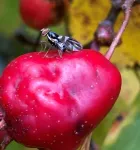(Press-News.org) Citrus cultivation holds significant importance in Japan and has recently attracted both domestic and global attention. With an agricultural production value of approximately 201 billion yen, citrus is the third most important agricultural product in Japan. The success of the Japanese citrus industry is attributed to the development of new cultivars that are free of pests and diseases, climate-resilient, and exhibit superior fruit quality. Notable examples include 'Asumi', 'Asuki', 'Ehimekashidai28go', 'Ehimekashidai48go', 'Himekoharu', 'Kanpei', 'Rinoka', and 'Mihaya', all of which display improved agricultural traits such as higher sugar content, resistance to diseases like citrus canker, and a reduced tendency to drip when cut.
There has, however, been a growing concern over the infringement and violation of breeding rights of citrus cultivars developed in Japan. This issue stems from their unauthorized export and cultivation overseas, followed by the importation of infringing fruit back into the country. This practice results in a loss of business in overseas markets, infringing the rights and severely jeopardizing the livelihoods of Japanese farmers. So, in 2021, the Japanese government revised the Plant Variety Protection and Seed Act to prevent overseas outflow of registered cultivars, safeguarding the rights of citrus breeders. Moreover, researchers developed cultivar-specific DNA identification systems such as cleaved amplified polymorphic site (CAPS) markers and TaqMan-MGB single-nucleotide polymorphism (SNP) genotyping assays, which could discriminate the target registered cultivar from others. However, these identification methods are time consuming and there is a growing need for faster and more user-friendly systems that can effectively identify Japanese cultivars, particularly at on-field inspection sites, so that the import of counterfeit fruit is curbed.
To this end, a group of Japanese researchers led by Associate Professor Yuki Monden from Okayama University and Mitsutoshi Okamoto of Ehime Research Institute of Citrus Fruits—and also comprising Takehiko Shimada of the National Agriculture and Food Research Organization, and Kazuto Takasaki and Tomoyuki Takeuchi of FASMAC Co. Ltd.—developed a new DNA marker-based cultivar identification system for eight prominent Japanese citrus cultivars. A paper detailing their study was made available online on 27 April 2023, and was published in Volume 73, Issue 2 of Breeding Science on 6 June 2023.
Speaking on their novel breakthrough, Prof. Monden says, “This system accurately identifies citrus cultivars by detecting DNA polymorphisms—fragments of DNA that are unique to each of the target cultivars.” The study employed genetic sequencing techniques to identify three retrotransposon families (CIRE1, Tcs1, and Tcs2) that are transcriptionally active in citrus plants. Retrotransposons are genetic elements that exhibit high copy numbers which can be used to detect cultivar-specific DNA polymorphisms. By analyzing their insertion sites through sequencing, unique DNA markers for specific cultivars were identified. These cultivar-identifying DNA markers comprising of polymorphic InDel (insertion-deletion) fragments in combination with a polymerase chain reaction (PCR)-positive marker for the ribulose-1,5-bisphosphate carboxylase/oxygenase (rbcL) gene were successfully detected within 15 minutes using a small membrane stick, the chromatographic printed array strip (C-Pas).
This straightforward process can be accomplished within one hour of DNA extraction and can clearly determine whether the tested fruit sample belongs to a registered cultivar. The developed system thus offers significant advantages as a convenient, rapid, and cost-effective DNA diagnostic method to inspect fruit imports. The proposed target cultivar-specific identification system is anticipated to function as an efficient tool for promptly identifying and acting against suspicious, unlicensed cultivars.
With time, Professor Monden hopes that this identification method can help strengthen the expansion of Japanese exports. “At present, the Japanese government is actively promoting the expansion of exports in the agricultural, forestry, fishery, and food sectors, with targets of achieving a 2-trillion-yen export value by 2025, which would expand to 5 trillion yen by 2030. While these efforts to boost exports are being strengthened, there is a growing concern regarding the piracy of excellent cultivars bred in Japan,” she says. She hopes their revolutionary work can enhance the competitiveness of Japanese cultivars by protecting the rights of breeders who breed them, eventually.
END
A novel solution to safeguard Japan's unique citrus cultivars and their breeders’ rights
Researchers have developed a rapid DNA diagnostic method to combat unauthorized international trade of citrus cultivars developed within Japan
2023-06-21
ELSE PRESS RELEASES FROM THIS DATE:
Study examines the use of silver diamine fluoride as an early childhood caries management strategy in Indigenous communities
2023-06-21
Alexandria, VA, USA – A study seeking to understand the perspectives of decision-makers (DMs) working within health fields in First Nations (FNs) communities in Canada regarding the use of Silver Diamine Fluoride (SDF) as an early childhood caries (ECC) management strategy will be presented at the 101st General Session of the IADR, which will be held in conjunction with the 9th Meeting of the Latin American Region and the 12th World Congress on Preventive Dentistry on June 21-24, 2023, in Bogotá, ...
IOP Publishing extends co-review policy to entire owned journal portfolio, delivering a collaborative and supportive experience for all reviewers
2023-06-21
IOP Publishing (IOPP) is rolling-out a new co-review policy across its entire owned journal portfolio as part of its commitment to ensuring an inclusive and supportive review process.
Early career researchers (ECRs) often support more experienced academics by contributing ideas or comments to peer review reports. Yet, according to a survey, 70% of ECRs say that their name was withheld from the editorial staff after they served as a reviewer or co-reviewer on a report, and they received no official recognition for their work.
IOPP’s ...
Can light therapy treat atrial fibrillation?
2023-06-21
New research published in the Journal of Internal Medicine demonstrates that optogenetics—which uses light-sensitive proteins to control the activity of targeted cells—is a promising shock-free approach to treating atrial fibrillation (AF), or an irregular, often rapid heart rate, for immediate restoration of regular rhythm.
Current treatments for AF—including medications and shocks to restore a regular heart rhythm—come with low success rates and/or serious side effects. ...
Can humor help treat depression and anxiety?
2023-06-21
An analysis of published studies suggests that humor therapy may lessen symptoms of depression and anxiety.
For the analysis, which is published in Brain and Behavior, investigators identified 29 relevant studies that included a total of 2,964 participants and were conducted in nine different countries. Participants had depression or anxiety and included children undergoing surgery or anesthesia; older people in nursing homes; patients with Parkinson's disease, cancer, mental illness, or receiving dialysis; retired women; and college ...
Could bamboo be the next source of renewable energy?
2023-06-21
An article in GCB Bioenergy describes why bamboo may be an attractive resource in efforts to develop environmentally friendly renewable energy to replace fossil fuels.
The authors note that bamboo grows rapidly, absorbs carbon dioxide, and releases large amounts of oxygen into the atmosphere. They describe various processes—such as fermentation and pyrolysis—that can be performed to convert its raw material into bioethanol, biogas, and other bioenergy products. A tool with limitations is currently available for selecting the most appropriate bamboo species ...
How does household water insecurity affect children’s health and well-being?
2023-06-21
The global burden of disease associated with water insecurity has traditionally focused on diarrheal disease as the most significant driver of infant and child mortality. However, a review in WIREs Water notes that there are many other ways that water insecurity can have adverse health and social consequences for children.
Inadequate or unsafe household water can have a range of health effects in children from infancy to late adolescence. Household water insecurity can spread disease, cause interruptions to growth and development, lead to school absenteeism and interpersonal violence, and contribute to other aspects of children’s mental and physical health.
“Because ...
Are health professionals in India adequately supporting breastfeeding?
2023-06-21
A review in Clinical & Experimental Allergy highlights a problematic relationship between the infant formula industry and allergy health professionals. The authors express concern that this could undermine breastfeeding in countries such as India, whose allergy management practices are often extrapolated from guidance developed in high-income countries with low breastfeeding rates.
The article by international experts in infant nutrition and allergy health documents the high rate of breastfeeding in India, where one-quarter ...
How do testosterone’s effects on the brain change from adolescence into adulthood?
2023-06-21
Higher testosterone levels during adolescence are associated with increased involvement of the brain’s anterior prefrontal cortex (aPFC) in emotion control, but the opposite effect occurs during adulthood. In a study published in Developmental Science, researchers investigated this switch by conducting brain imaging scans in the same individuals during middle adolescence, late adolescence, and young adulthood.
The study, which included 71 participants, demonstrated that the positive effect of testosterone ...
Climate change could lead to "widespread chaos" for insect communities
2023-06-21
BINGHAMTON, N.Y. -- New species continue to evolve the world over, as different groups of organisms separate and take divergent paths. What happens when you add climate change to the mix?
That’s the question Thomas H.Q. Powell, assistant professor of biological sciences at Binghamton University, State University of New York, and his lab seek to answer in “Contrasting effects of warming in diverging insects,” recently published in Ecology Letters.
In the 1850s, the apple maggot fly — a major agricultural pest ...
PFAS found in blood of dogs, horses living near Fayetteville, NC
2023-06-21
In a new study, researchers from North Carolina State University detected elevated PFAS levels in the blood of pet dogs and horses from Gray’s Creek, N.C. – including dogs that only drank bottled water. The work establishes horses as an important sentinel species and is a step toward investigating connections between PFAS exposure and liver and kidney function in dogs and horses.
The study included 31 dogs and 32 horses from the community, and was conducted at the behest of community members concerned about their pets’ well-being. All of the households in the ...
LAST 30 PRESS RELEASES:
Statins significantly reduce mortality risk for adults with diabetes, regardless of cardiovascular risk
Brain immune cells may drive more damage in females than males with Alzheimer’s
Evidence-based recommendations empower clinicians to manage epilepsy in pregnancy
Fungus turns bark beetles’ defenses against them
There are new antivirals being tested for herpesviruses. Scientists now know how they work
CDI scientist, colleagues author review of global burden of fungus Candida auris
How does stroke influence speech comprehension?
B cells transiently unlock their plasticity, risking lymphoma development
Advanced AI dodel predicts spoken language outcomes in deaf children after cochlear implants
Multimodal imaging-based cerebral blood flow prediction model development in simulated microgravity
Accelerated streaming subgraph matching framework is faster, more robust, and scalable
Gestational diabetes rose every year in the US since 2016
OHSU researchers find breast cancer drug boosts leukemia treatment
Fear and medical misinformation regarding risk of progression or recurrence among patients with breast cancer
Glucagonlike peptide-1 receptor agonists and asthma risk in adolescents with obesity
Reviving dormant immunity: Millimeter waves reprogram the immunosuppressive microenvironment to potentiate immunotherapy without obvious side effects
Safety decision-making for autonomous vehicles integrating passenger physiological states by fNIRS
Fires could emit more air pollution than previously estimated
A new way to map how cells choose their fate
Numbers in our sights affect how we perceive space
SIMJ announces global collaborative book project in commemoration of its 75th anniversary
Air pollution exposure and birth weight
Obstructive sleep apnea risk and mental health conditions among older adults
How talking slows eye movements behind the wheel
The Ceramic Society of Japan’s Oxoate Ceramics Research Association launches new international book project
Heart-brain connection: international study reveals the role of the vagus nerve in keeping the heart young
Researchers identify Rb1 as a predictive biomarker for a new therapeutic strategy in some breast cancers
Survey reveals ethical gaps slowing AI adoption in pediatric surgery
Stimulant ADHD medications work differently than thought
AI overestimates how smart people are, according to HSE economists
[Press-News.org] A novel solution to safeguard Japan's unique citrus cultivars and their breeders’ rightsResearchers have developed a rapid DNA diagnostic method to combat unauthorized international trade of citrus cultivars developed within Japan



